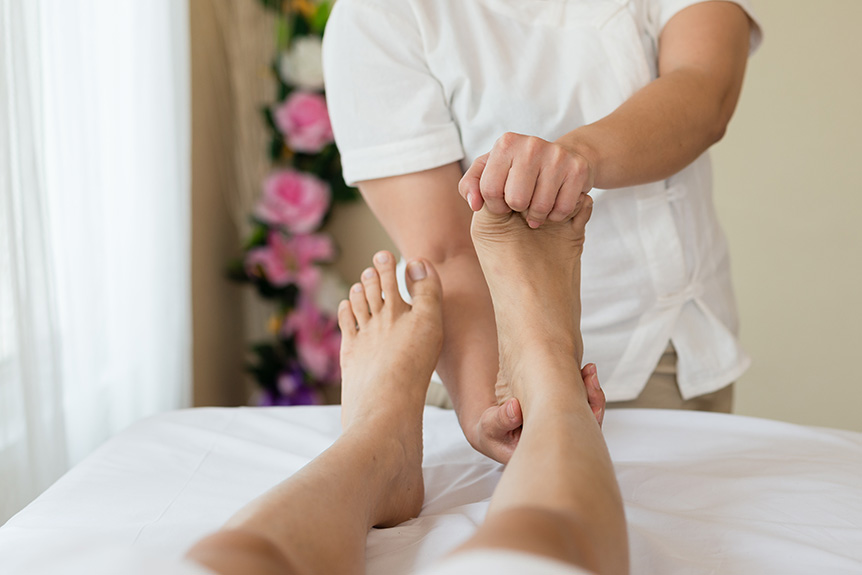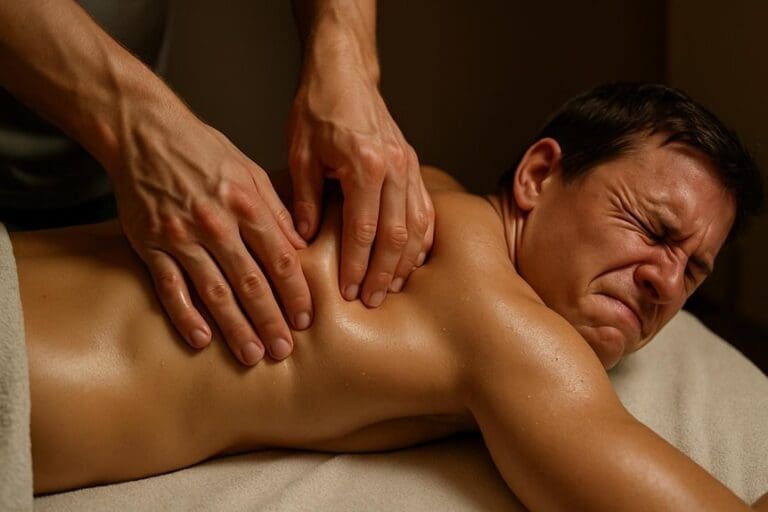This may offer modest relief in fibromyalgia by modulating central sensitisation and autonomic imbalance. Gentle pressure to foot and hand reflex zones engages mechanoreceptors, influences dorsal horn gating, and promotes parasympathetic upregulation, potentially reducing pain, muscle tension, and sleep fragmentation. Small trials show improvements in pain, sleep, and anxiety, with signals in heart-rate variability and cortisol, though evidence quality is limited. It is generally safe with tailored, low-pressure techniques to avoid flares. Further details clarify mechanisms, safety, and session planning.
Understanding Fibromyalgia and Its Common Symptoms
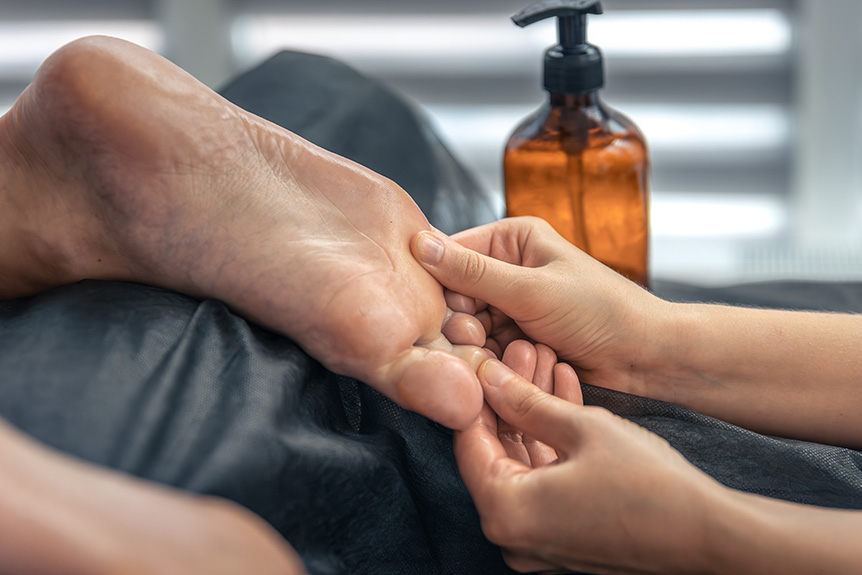
What underlies fibromyalgia is a central sensitisation process in which nociceptive pathways become hyperexcitable, amplifying pain perception without overt peripheral tissue damage. Descending inhibitory systems appear blunted, autonomic balance shifts toward sympathetic arousal, and sleep architecture is often fragmented—together sustaining widespread pain and profound fatigue.
Patients frequently report allodynia, hyperalgesia, morning stiffness, cognitive fog, irritable sleep, and heightened sensitivity to sound, light, or temperature. Gastrointestinal disturbance, headache, dysautonomia (orthostatic intolerance, palpitations), and mood symptoms commonly coexist, reflecting network-level neuroimmune and neuroendocrine dysregulation rather than localized injury.
From Spa & Massage’s clinical perspective in London, careful history-taking, gentle pacing, and sensory-aware environments help accommodate hypersensitivity. Therapists consider pressure titration, breath-led relaxation, and session timing around sleep and flare patterns, always coordinating with clients’ broader medical care. Some practitioners may also incorporate techniques from aromatherapy massage to enhance relaxation and offer supportive care for those experiencing heightened sensitivity.
What Is Reflex Therapy and How Does It Work?
Reflexology is a manual therapy applying graded pressure to specific zones on the feet, hands, or ears that are mapped to organ systems via reflex charts. Proposed mechanisms include modulation of autonomic balance, activation of cutaneous and deep mechanoreceptors, and consequent shifts in central pain processing.
Contemporary models suggest pressure inputs travel via A-beta and C-fibre pathways to dorsal horn interneurons, influencing spinal gating and descending inhibitory networks. Parasympathetic upregulation may reduce sympathetic arousal, easing muscle tone and vascular resistance.
At Spa & Massage clinics in London, therapists apply precise, tolerable pressure sequences, monitoring tissue texture, temperature, and client-reported sensations to tailor load and pacing. Evidence indicates that it can alter heart-rate variability and perceived stress, aligning with autonomic recalibration.
Sessions prioritize comfort, steady breathing, and gentle aftercare to consolidate neuromodulatory effects.
Potential Benefits of This Therapy for Fibromyalgia
For individuals with fibromyalgia, targeted pressure point therapy may attenuate central sensitisation and autonomic dysregulation—two core features of the syndrome—by modulating afferent input from cutaneous and deep mechanoreceptors to spinal gating and descending inhibitory pathways.
This neuromodulatory effect can reduce hyperalgesia and allodynia while easing sympathetic overactivity that fuels fatigue, sleep fragmentation, and irritable bowel symptoms.
What the Research Says About This Therapy and Fibromyalgia
Emerging but heterogeneous evidence suggests that it may confer modest symptom relief in fibromyalgia. Small randomized and controlled trials have reported reductions in pain intensity, sleep disturbance, and anxiety relative to attention or sham controls. Effect sizes are generally small to moderate, and methodological risks include limited blinding integrity, short follow-up, and variable dosing.
Proposed mechanisms align with fibromyalgia pathophysiology: downregulation of central sensitisation, modulation of autonomic imbalance (reduced sympathetic arousal, improved vagal tone), and attenuation of peripheral nociceptor drive via pressure‑evoked gate control.
Preliminary biomarker signals include improved heart‑rate variability and modest cortisol normalisation. Safety profiles appear favourable, with transient soreness most common.
From Spa & Massage’s perspective, these findings justify cautious integration as an adjunct, while emphasising realistic expectations and outcome‑guided review.
How We Tailor Massage Sessions for Fibromyalgia at Spa & Massage
Why individualisation matters becomes clear when considering fibromyalgia’s heterogeneity—widespread nociplastic pain, autonomic dysregulation, sleep disturbance, and sensory hypersensitivity vary by patient.
At Spa & Massage, therapists calibrate pressure point therapy and pacing to reduce central sensitisation risk while still engaging mechanoreceptors that modulate dorsal horn signaling. Mapping tender points and flare thresholds guides shorter, slower sequences, prioritising parasympathetic shift via diaphragmatic-paced foot work and prolonged holds along solar plexus, adrenal, and vagal-reflex areas.
When sleep fragmentation dominates, they emphasise circadian-soothing rhythms and warming mediums to support distal vasodilation.
With autonomic lability—orthostatic symptoms, palpitations—they avoid abrupt transitions, maintaining steady, low-load input.
For coexisting myofascial load, they pair gentle reflex contacts with minimal-amplitude ankle and toe mobilisations.
Documentation tracks symptom trajectories, enabling conservative progression while safeguarding comfort and consent.
What to Expect During Your First Massage Appointment
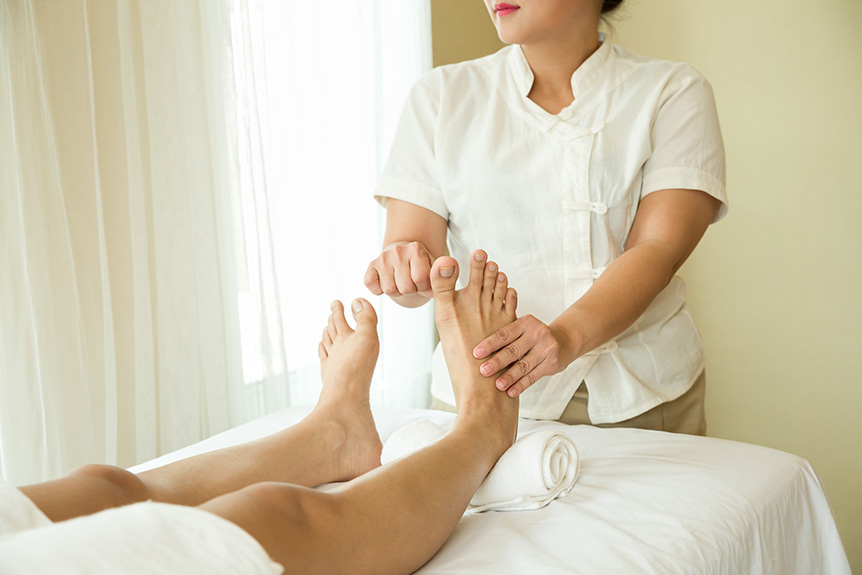
At Spa & Massage, a first zone therapy visit begins with a concise consultation to document symptoms, comorbidities, medications, pain thresholds, and autonomic factors relevant to fibromyalgia’s central sensitisation.
The session typically proceeds with graded pressure along mapped foot zones, monitoring for hyperalgesia and allodynia while modulating stimulus intensity to reduce sympathetic arousal.
Sensations may range from dull pressure to transient tenderness; therapists explain these responses as mechanoreceptor input intended to support parasympathetic tone and sleep-wake regulation.
Consultation and Health History
A first massage appointment at Spa & Massage begins with a structured consultation to document health history and current symptom patterns, particularly pain distribution, sleep disturbance, autonomic symptoms, and fatigue load common in fibromyalgia.
Therapists map tender points, neuropathic descriptors, and diurnal variation, and review comorbidities such as IBS, migraine, POTS-like features, and mood symptoms that modulate central sensitisation.
Medication use, pain flares, exercise tolerance, and prior manual therapy responses are recorded to identify allostatic load and triggers.
Vital considerations include peripheral circulatory status, edema, skin integrity, and neuropathy risk that may alter pressure tolerances.
Red flags are screened to ensure safety and appropriate referral.
This interview shapes a therapy plan aimed at calming sympathetic overactivity, supporting sleep architecture, and respecting each client’s thresholds.
Treatment Flow and Sensations
Following the consultation, the therapist positions the client semi-reclined to reduce orthostatic load, and begins with warm compresses to the feet to improve local microcirculation.
A neutral, hypoallergenic oil is applied sparingly. The sequence proceeds from diaphragmatic and solar plexus points to spinal, adrenal, and gut reflex zones, then distal-to-proximal foot maps. Pressure is modulated to avoid nociceptor wind-up common in fibromyalgia.
Clients often report gradients of heat, tingling, or dull ache that ease within seconds—signals of mechanoreceptor gating and autonomic downshift.
At Spa & Massage in London, therapists monitor breath cadence and muscle tone, pausing when guarding appears.
Sessions last 45–60 minutes, concluding with gentle lymphatic strokes and a brief sit-up period to prevent orthostatic symptoms.
Hydration and paced rest are recommended post-session.
Safety Considerations and Who Should Avoid Zone Therapy
It is generally well tolerated, but specific pathophysiological states warrant caution or avoidance due to potential hemodynamic, neurologic, or thromboembolic risks.
Individuals with unstable cardiovascular disease, poorly controlled hypertension, recent myocardial infarction, or decompensated heart failure should defer treatment, as autonomic shifts may alter blood pressure or heart rate.
Active deep vein thrombosis, recent surgery, or anticoagulation with bleeding diathesis increases embolic or hematoma risk under sustained foot or hand pressure.
Peripheral neuropathy (e.g., diabetes, chemotherapy-induced) may blunt protective sensation and invite tissue injury.
Acute infections, fever, or severe dermatitis of the feet or hands also preclude therapy.
Pregnancy with obstetric complications warrants medical clearance.
At Spa & Massage, therapists triage for red flags, adjust pressure, and coordinate with clinicians to protect those with fibromyalgia.
At-Home Self-Care Tips to Complement Zone Therapy
Safety parameters set in clinic inform self-management between sessions, where consistent inputs can modulate nociceptive gain, autonomic tone, and sleep architecture in fibromyalgia.
At Spa & Massage, therapists encourage gentle foot and hand self-reflex stimulation for 5–8 minutes daily, using light-to-moderate pressure to avoid wind-up.
Slow diaphragmatic breathing (4–6 breaths/min) before and after self-work reduces sympathetic drive and supports vagal tone.
Warmth—such as a brief footbath—primes tissue perfusion and decreases guarding.
For sleep consolidation, a fixed lights-out, blue-light reduction after dusk, and a 10-minute body-scan are recommended to dampen hyperarousal.
Low-load movement (short walks or mobility drills) interrupts central sensitisation without provoking flares.
Hydration and magnesium-rich foods may aid muscle relaxation.
In our clinics, unscented or gentle lavender blends are advised to avoid sensory overload.
How Often to Book a Massage Session and Building a Supportive Care Plan
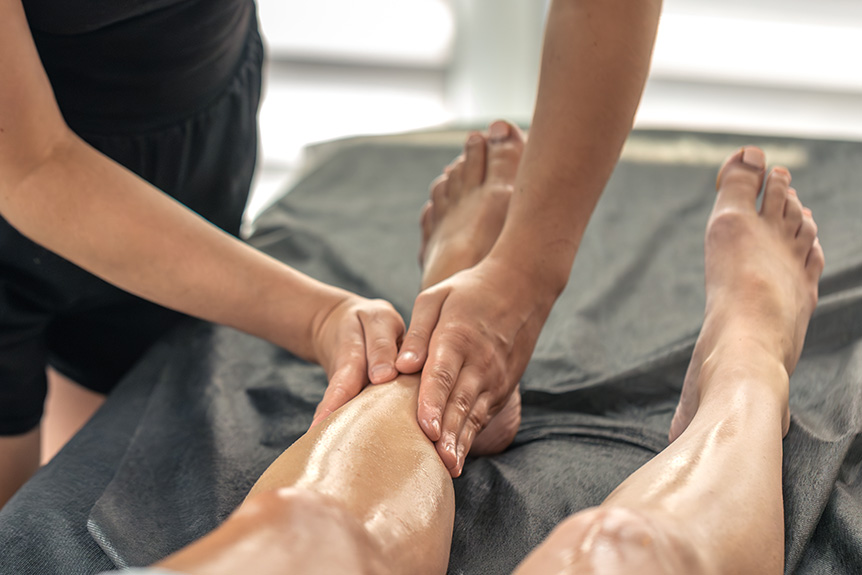
An effective scheduling strategy for fibromyalgia zone therapy aligns session frequency with known patterns of central sensitisation, autonomic dysregulation, and sleep disturbance.
In Spa & Massage clinics, therapists typically suggest an initial loading phase of weekly sessions for 4–6 weeks to modulate nociplastic pain, calm sympathetic overactivity, and stabilise sleep-wake rhythms.
If pain intensity, flare frequency, and sleep latency improve, frequency tapers to fortnightly, then every 3–4 weeks for maintenance.
A supportive plan integrates gentle movement, paced activity, and sleep hygiene, with zone therapy timed earlier in the evening to encourage parasympathetic dominance.
Outcome tracking uses simple metrics: pain scores, tender point reactivity, sleep duration, and post-session recovery time.
Therapists coordinate with clients’ clinicians, adjust pressure for allodynia, and avoid overloading during flares.
Conclusion
As the session ends, muscles soften like ripples settling on a quiet lake. While this does not alter fibromyalgia’s central sensitization, it may modulate autonomic tone, reduce sympathetic drive, and ease myofascial guarding—mechanisms linked to pain amplification, sleep fragmentation, and fatigue. Clients often leave with steadier breathing and warmer extremities, subtle signs of improved perfusion and downregulated stress pathways. Integrated with medical care, paced activity, and sleep hygiene, it can be a gentle bridge toward calmer days and more restorative nights.
